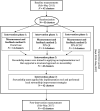A multicentre cluster-randomized clinical trial to improve antibiotic use and reduce length of stay in hospitals: comparison of three measurement and feedback methods
- PMID: 33638644
- PMCID: PMC8120330
- DOI: 10.1093/jac/dkab035
A multicentre cluster-randomized clinical trial to improve antibiotic use and reduce length of stay in hospitals: comparison of three measurement and feedback methods
Abstract
Background: Various metrics of hospital antibiotic use might assist in guiding antimicrobial stewardship (AMS).
Objectives: To compare patient outcomes in association with three methods to measure and feedback information on hospital antibiotic use when used in developing an AMS intervention.
Methods: Three methods were randomly allocated to 42 clusters from 21 Dutch hospitals: (1) feedback on quantity of antibiotic use [DDD, days-of-therapy (DOT) from hospital pharmacy data], versus feedback on (2) validated, or (3) non-validated quality indicators from point prevalence studies. Using this feedback together with an implementation tool, stewardship teams systematically developed and performed improvement strategies. The hospital length of stay (LOS) was the primary outcome and secondary outcomes included DOT, ICU stay and hospital mortality. Data were collected before (February-May 2015) and after (February-May 2017) the intervention period.
Results: The geometric mean hospital LOS decreased from 9.5 days (95% CI 8.9-10.1, 4245 patients) at baseline to 9.0 days (95% CI 8.5-9.6, 4195 patients) after intervention (P < 0.001). No differences in effect on LOS or secondary outcomes were found between methods. Feedback on quality of antibiotic use was used more often to identify improvement targets and was preferred over feedback on quantity of use. Consistent use of the implementation tool seemed to increase effectiveness of the AMS intervention.
Conclusions: The decrease in LOS versus baseline likely reflects improvement in the quality of antibiotic use with the stewardship intervention. While the outcomes with the three methods were otherwise similar, stewardship teams preferred data on the quality over the quantity of antibiotic use.
© The Author(s) 2021. Published by Oxford University Press on behalf of the British Society for Antimicrobial Chemotherapy.
References
-
- WHO. Antimicrobial resistance: global report on surveillance 2014. http://www.who.int/drugresistance/documents/surveillancereport/en/.
-
- Schuts EC, Hulscher ME, Mouton JW. et al. Current evidence on hospital antimicrobial stewardship objectives: a systematic review and meta-analysis. Lancet Infect Dis 2016; 16: 847–56. - PubMed
-
- van Daalen FV, Prins JM, Opmeer BC. et al. Effect of an antibiotic checklist on length of hospital stay and appropriate antibiotic use in adult patients treated with intravenous antibiotics: a stepped wedge cluster randomized trial. Clin Microbiol Infect 2017; 23: 485.e1–458.e8. - PubMed
-
- van den Bosch CM, Hulscher ME, Akkermans RP. et al. Appropriate antibiotic use reduces length of hospital stay. J Antimicrob Chemother 2017; 72: 923–32. - PubMed
-
- Spoorenberg V, Hulscher ME, Akkermans RP. et al. Appropriate antibiotic use for patients with urinary tract infections reduces length of hospital stay. Clin Infect Dis 2014; 58: 164–9. - PubMed
Publication types
MeSH terms
Substances
LinkOut - more resources
Full Text Sources
Other Literature Sources
Medical
Research Materials


